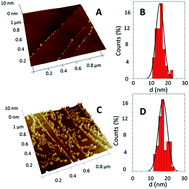M. Martín, P. Salazar, S. Campuzano, R. Villalonga, J.M. Pingarrón, J.L. González-Mora
Analytical Methods, 7 (2015) 8801-8808
doi: 10.1039/C5AY01996F
The synthesis of poly(dopamine)-modified magnetic nanoparticles (MNPs) and their application in preparing electrochemical enzyme biosensors that are useful to detect phenolic compounds is reported in this work. MNPs of about 16 nm were synthesized by a co-precipitation method and conveniently modified with poly(dopamine). Non-modified and modified MNPs were characterized using X-ray photoelectron spectroscopy (XPS), Raman and infrared spectroscopy, X-ray diffraction (XRD) and atomic force microscopy (AFM). Horseradish peroxidase (HRP) was covalently immobilized onto the surface of the poly(dopamine)-modified MNPs via Michael addition and/or Schiff base formation and used to construct a biosensor for phenolic compounds by capturing the HRP-modified-nanoparticles onto the surface of a magnetic-modified glassy carbon electrode (GCE). Cyclic voltammetry and amperometry were used to study the electrochemical and analytical properties of the biosensor using hydroquinone (HQ) as a redox probe. Among the different phenolic compounds studied, the biosensor exhibited higher sensitivity for HQ, 1.38 A M−1 cm−2, with limits of detection and quantification of 0.3 and 1.86 μM, respectively. The analytical biosensor performance for HQ and 2-aminophenol compared advantageously with those of previous phenolic biosensors reported in the literature.


